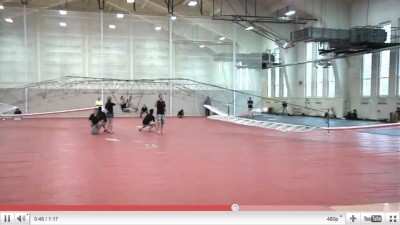Fri, Aug 19, 2011
Clark School Student Team Sets New U.S. Flight Records at 11.4
Seconds
The National Aeronautic Association has certified that on July
13, 2011, the human-powered helicopter Gamera, designed and built
by graduate and undergraduate students at the University of
Maryland's A. James Clark School of Engineering and piloted by
biology student Judy Wexler, achieved lift-off and hovered for 11.4
seconds, setting the new U.S. records for flight duration and
flight duration by a female pilot.
You Tube Frame Capture

The NAA has submitted information to the Federation Aeronautique
Internationale to permit evaluation of the July flight for world
records in the same categories. The NAA states that this process
may take two to three months. The team's May flight is still being
evaluated by the FAI.
"Competitions like the human-powered helicopter bring out the
best in Clark School students and show that they are fully prepared
to contribute to technological progress," stated Clark School Dean
Darryll Pines. "The new record is exciting and meaningful,
but the real accomplishment is the students' learning that they can
successfully apply their skills in an incredibly challenging
engineering problem."

The team is evaluating the current vehicle and the next steps
towards competing for the Sikorsky Prize. The prize was established
by the American Helicopter Society and requires an individual or
team to build a helicopter powered only by human means that can
lift off and achieve a hover time of 60 seconds and reach a height
of 3 meters sometime during a 60-second flight while remaining in a
10 square-meter area.
"Through the development of Gamera we have learned many things
about extreme ground effect aerodynamic design and also about
lightweight structural design," said one of the team's student
leaders, Joe Schmaus. "At this point we are combining these two
knowledge bases to determine whether to go for another
record-setting, but not prize-winning, flight with Gamera or put
all our energy into designing a vehicle capable of the Sikorsky
prize."
More News
He Attempted To Restart The Engine Three Times. On The Third Restart Attempt, He Noticed That Flames Were Coming Out From The Right Wing Near The Fuel Cap Analysis: The pilot repor>[...]
Make Sure You NEVER Miss A New Story From Aero-News Network Do you ever feel like you never see posts from a certain person or page on Facebook or Instagram? Here’s how you c>[...]
From 2009 (YouTube Edition): Leading Air Show Performers Give Their Best Advice for Newcomers On December 6th through December 9th, the Paris Las Vegas Hotel hosted over 1,500 air >[...]
Aero Linx: NASA ASRS ASRS captures confidential reports, analyzes the resulting aviation safety data, and disseminates vital information to the aviation community. The ASRS is an i>[...]
“For our inaugural Pylon Racing Seminar in Roswell, we were thrilled to certify 60 pilots across our six closed-course pylon race classes. Not only did this year’s PRS >[...]
 NTSB Final Report: Rutan Long-EZ
NTSB Final Report: Rutan Long-EZ ANN FAQ: Turn On Post Notifications
ANN FAQ: Turn On Post Notifications Classic Aero-TV: ICAS Perspectives - Advice for New Air Show Performers
Classic Aero-TV: ICAS Perspectives - Advice for New Air Show Performers ANN's Daily Aero-Linx (06.28.25)
ANN's Daily Aero-Linx (06.28.25) Aero-News: Quote of the Day (06.28.25)
Aero-News: Quote of the Day (06.28.25)




